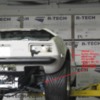Not to overcomplicate the matter, but like most things when we start fiddling with tire diameters, ride heights, etc, there can be other impacts. It’s worth noting that the majority of wide rubber tire choices opted for by Pantera owners today are typically smaller in diameter than original equipment. These end up being in a fairly narrow range for stock bodied cars but when you start fitting flares, it expands the choices and thus related issues much more.
So when a smaller outside diameter tire is selected, this actually drops the car by half the reduction in tire diameter. Then aesthetically, the eye notices a slightly greater gap between tire OD and wheel arch, and this of course also creates a little more wheel well clearance so the car can be further lowered.
A lower center of gravity is certainly a good thing to the extent the result allows sufficient ground clearance for a practical street car (if that’s your goal), but here are a couple other things to consider.
Reducing tire diameter will lower the overall gearing of your car. This may provide a little improvement in acceleration but will increase engine rpm at cruise; a factor many Pantera owners grapple with. The affect of these changes tend to be subtle but not insignificant over the range of choices. So for example here are some popular tire diameters mentioned in recent threads and 2500 rpm 5th gear speed.
315/35/17 = 25.68” diameter = 64 mph
335/35/17 = 26.23” diameter = 66 mph
OE Tires = 26.5” diameter = 66 mph
345/30/19 = 27.15” diameter = 68 mph (my Choice)
345/35/19 = 28.51” diameter = 71 mph
...and there are of course many other combinations in between these tire diameters and you aren’t going to get the last two into stock wheel wells on narrow body cars.
You can play around with Mike Daley’s or RBT’s spreadsheet and conclude in this range you get about 36 rpm change for every 1 mph, or in the examples above you get a about a 250 rpm difference across the entire range of tire sized at 66 mph or half that on either side of the OE tire size. Still in other terms, for those of you that consider gearing changes, for constant rpm of 2500 and 66 mph in 5th gear, it’s equivalent to changing your ring and pinion from ~4.4 to 3.95 across the entire range. Is any of this significant? -You decide.
Then there are suspension impacts to consider. Though it may require change of shocks, you can adjust your suspension to desired ride height. Most generally shoot for lower rear A-arms parallel to the ground because +- travel about this point tends to have minimal affect on rear wheel geometry. In the front suspension of the car we start talking about happy mediums for wheel well clearance at full lock and bump steer. Again, there are more choices and the game can change with flared cars especially if you are custom fitting them around your wheels. Bigger front wheels mean you can fit bigger brake rotors. With the wider rubber possible with flared cars you become more aware of the caster and scrub radius limitations of stock suspension are going to affect handling behavior for wider front wheels. –Lot’s of trade-offs.
Best Regards,
Kelly



